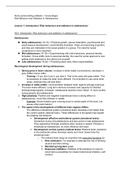Korte samenvatting artikelen + hoorcolleges
Risk Behavior and Addiction in Adolescence
Lecture 1: Introduction ‘Risk behaviour and addiction in adolescence’
HC1: Introduction ‘Risk behaviour and addiction in adolescence’
Adolescence:
Early adolescence (10-13) = Physical growth, sexual maturation, psychosocial and
psychosexual development, social identity formation. Peers are becoming important,
and they are interested in the social position in a group. The need for social
acceptance is more important.
Mid adolescence (14-18) = Experimenting with (risk) behaviors, personal identity
formation. Focus shifts more to personal identity, the need for social approval is now
getting more balanced to the need to be yourself.
Late adolescence (19-24) = Practicing adult roles. More responsibilities.
Neurological development during adolescence:
1. Strong grow in brain volume: increase in white matter (connections), decrease in
grey matter (nerve cells).
- Pruning = If you don’t use it, you lose it. That is the case with gray matter. This
is necessary to make the brain more efficient. It is important to use some brain
areas, whereas they will lose them.
2. Increase in white matter: communication between brain regions strongly improves.
The brain works efficient. Long term memory increases and capacity for abstract
thinking/metacognition increases. Adolescents become more critical. more conflict
during parents and adolescents.
3. High plasticity: Positive and negative experiences have a strong effect on
adolescences, more than children or adults.
- Example: Social isolation give a strong boost to certain parts of the brain, but
leaves other parts behind.
4. The speed of the development of different brain regions differs:
- The affective-motivational system (emotional brain) develops much faster than
the control system (rational brain). These differences in the speed may explain
the peaking risk behavior.
Development affective-motivational system (emotional brain):
Overactive during mid-adolescence and less active in late adolescence.
They experience stronger emotions when receive a reward. Process is
enhanced by testosterone, so more influence with boys.
Development control system (rational brain): Rational brain (centered
in the prefrontal cortex) develops slowly and much slower than the
emotional brain.
o The rational brain plays an important role executive functions as:
1. Risk estimation. For example to estimate the risk of drinking
alcohol and then driving.
2. Monitoring long-term goals.
3. Response inhibition: inhibition of the tendency to react to
(short-term) possibilities for reward (behavioral inhibition, self-
control).
,Why do adolescence show more risk behavior than children or adults?
The Maturational Imbalance Model = Increased risk-taking during adolescence is a
result of an imbalance between (emotional brain) motivational bottom-up versus
(rational brain) controlling top-down processes (heightened reward sensitivity versus
immature impulse control).
Alternative theory (Dobbs): the adaptive adolescence view = The teen is not only
‘work in progress’, but ‘an exquisitely sensitive, highly adaptable creature wired
almost perfectly for the job of moving from the safety of home intro the complicated
outside world.’ It is the result of evolutionary principles and adaptation.
Definitions:
Risk behavior = Behaviors that pose a risk to a healthy physical, cognitive,
psychosocial development of adolescents. This can be substance use or other risk
behaviors which can result in addiction.
Importance of context: (1) characteristics of the particular substance or behavior,
(2) cultural and societal norms and (3) scientific knowledge.
Drugs/psychoactive substances = Chemical substances that cross the blood-brain
barrier and affect the function of the central nervous system thereby altering
perception, mood, or consciousness. Other characteristics are craving after regular
use and people often evoke loss of control after they have been used regularly.
Addiction (Sussman (2017)):
- Intentional addiction = These definitions aim to describe a causal addiction
process. The processes that underly the development of an addiction.
- Extensional addiction = A classification of characteristics of an addiction in the
DSM-5. There is a difference between light, moderate and severe substance use
disorder. They reflect: (1) impaired control, (2) social and other impairments, (3)
continuation despite knowledge of risky use and (4) pharmacological effects.
The general process of addiction: (1) Contact with a substance, (2) experimenting
with a substance, (3) integrated use, (4) excessive use and (5) addicted use.
Dutch adolescents substance abuse:
Alcohol and cigarette use: Same for the Netherlands and other countries. The results
indicate prevalence rates relatively close to the average.
Heavy drinking and lifetime use: Higher average in the Netherlands.
Development of addiction:
2 learning principles underlying the development of addiction:
, 1. Positive reinforcement = This occurs when the rate of a behavior increases
because of a desirable event is resulting from the behavior.
2. Negative reinforcement = This occurs when the rate of a behavior increases
because an aversive event is prevented from happening (prevention of withdrawal
symptoms).
Tolerance: Decrease in sensitivity of the brain reward system. There is a reduction
number of dopamine receptors, making the receptors less sensitive to dopamine
- Results: Tolerance, withdrawal symptoms during abstinence and a reduced
sensitivity to natural incentives.
Rational decision making models:
Theory of Planned Behavior = The idea is that people balance the benefits and
costs before behaving. The intention to engage is the result of 3 components:
attitude, subjective norm and perceived self-efficacy (do you think you can do it?).
Dual process models or risky decision making = Underlying assumption: Risk
behavior is not resulting from rational decision making but from a much more
implicit/less deliberate decision making process as well.
- Figure: Substance use can be a result of social context with implicit preferences.
The circumstances is an important role, but also the willingness.
, - Implicit association test = Tries to measure these implicit cognitions. These
are words/pictures and you got to respond positive or negative. The faster the
respondent responses with positive associations with alcohol, the stronger the
implicit cognitions with alcohol.
Sidenote: Validity is subject of debate. Still improving.
- Implicit process in stages of addiction: Emphasize that the processes play a
more important role in the later stages of addiction. An example is that people
who are smoking already, show more craving to cigarettes when someone
shows them a picture of a party.





